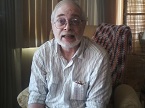moore4807
Posts: 1089
Joined: 6/2/2000
From: Punta Gorda FL
Status: offline

|
quote:
ORIGINAL: brotherbaldrick
What we've found (and it's not particularly to anyone's liking) is that the game engine is a bit quirky when calculating air to air results, main points it uses seems to be:
I question the quirky comment, since the results seem to follow tactics that were in use of those days. Attacking high and with the sun behind them was the (almost) universally preferred tactic, the AVG taught pilots to make one high angle attack then extend and escape utilizing the P-40's weight and speed to avoid counter attacks by the Japanese fighters, living to fight another day (and preserving the planes). The early warning network Chennault set up helped his pilots have enough time to scramble and gain precious altitude before the bombers/fighters came.
1) numbers, on each side -
Agreed although in the game we are able to put unrealistic amounts of planes into one area (the RA stacking rules help greatly) but in they offset each other - so no harm done.
2) altitude - this is a real killer as it seems to trump everything else - the higher you are the better - this is also where it is sometimes necessary to have a house rule, because otherwise combat success invariably goes to the player who has fighters with the highest max altitude!
I always disagreed with this house rule when I read it. Why aren't players splitting thier squadrons into two or three, and layering the coverage? (20K, 15K, 10K altitudes?)
3) Speed - the faster the better, as a Jap player you are always going to suffer on this one. (R&D your double act a.k.a the Frank and George show! These two boys are the only ones that can really make a difference within a reasonable time frame)
I respectfully disagree, at least as the first two years of the war...The A6M2 Zero is both more agile and faster than ANY allied fighter until 1943. The difference is in the firepower - the Allies planes are much better armored than the Japanese, which means many Allied kills are scored where an equal Japanese hit gets only a damaged Allied plane, as it was IRL.
4) Pilots and leaders skills
Agreed - this is where the Allies have a huge advantage later in the war unless the Japanese player throws many exp pilots into TRACOM early in the game.
Maneuverability as far as I can tell plays very little part in the air to air calculations. Speed and altitude are the big two.
I think manueverability is as important in lower altitude dogfights and the Japanese tend to do much better, except the Claudes and Nates - they are flying coffins unless they are flying against the (non-AVG) Chinese.
As the IJ you are always going to lack firepower (gun rating vs allied fighters), especially early on - you have to make up for this with numbers, otherwise you wont down as many allied a/c, you damage them, but don't kill as many of them.
I totally agree, but I believe its because of the armor issue more than the altitude issue IMHO. Overall I think the game designers really got it right in the air war,
I remember reading an article about not as many kills as claimed in WWII, if there were the USAAF/USN/USMC would have been out of planes in the Pacific by 1943 based on Japanese kill claims research done by some war historian, many claimed kills managed to limp home, and at worst they became parts for other aircraft if not restored to flying status.
brotherbaldrick - I appreciate your comments and your beliefs. I am posting what I found in the game and while I'm a noob, I played the A.I. in probably 40-50 campaigns and scenarios over the last two years. I am also a lifelong WWII hobbyist and have gone to several war museums and read more books than I can recall about this subject. PLEASE accept this as my viewpoint and not as a superiority posting. I thank you for taking the time to read and post in this AAR and encourage you to continue posting. If you disagree with me thats fine, I accept criticism readily and always learn something new everyday!
_____________________________
|
 Printable Version
Printable Version































 New Messages
New Messages No New Messages
No New Messages Hot Topic w/ New Messages
Hot Topic w/ New Messages Hot Topic w/o New Messages
Hot Topic w/o New Messages Locked w/ New Messages
Locked w/ New Messages Locked w/o New Messages
Locked w/o New Messages Post New Thread
Post New Thread